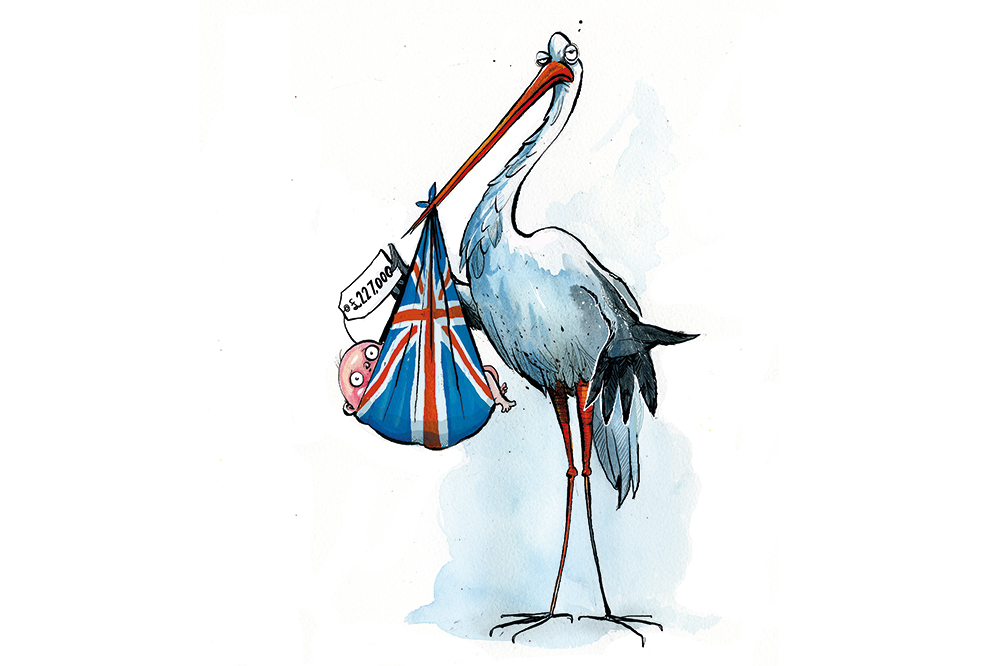No nation in history is known to have emerged from the grip of long-term low birth rates. This sobering reality should be somewhat concerning, given that 70 per cent of the world’s people now live in countries that are below the replacement-level tipping point – countries where, on average, women have fewer than two surviving children. More worrying still, this crisis has no known solution, countless governmental incentives having failed to raise birth rates or having had only a short-lived impact. Yet, after eight years researching this phenomenon and producing the documentary Birthgap – Childless World, I am left with a hint of optimism for the next generation.
In the UK last year, 900,000 adults celebrated their 50th birthday, while only 700,000 births were recorded – a 23 per cent deficit or ‘birthgap’. France has a similar figure of 24 per cent, putting these nations at the better end of the scale. Germany’s is 35 per cent, meaning that for every three future retirees, there will be only two new-hires available to enter the workforce. But it gets worse: Spain and Japan both have a staggering 55 per cent birthgap, with less than one available new-hire for every two future retirees. Italy has just been confirmed as having the fewest workers aged under 35 in Europe compared to its total population – its birthgap has now reached 58 per cent. And even they are outdone by South Korea, where there’s a frightening 71 per cent birthgap – i.e. one new-hire for every three future retirees. The US has also caught onto the trend, with a widening 15 per cent birthgap overall, and New England leading the way with 29 per cent fewer newborns than 50-year-olds.
Between 93 per cent and 96 per cent of women plan to become mothers – many more than actually achieve it
Birthgaps are significant socially and economically. Our ageing societies will suffer from an ever smaller tax base to fund our elderly. In the UK, the Treasury will struggle to maintain the nation’s precious NHS budgets, given that 60 per cent of healthcare costs are incurred by the over-75s. State pensions will become increasingly unsupportable, closed-down schools will tear at the heart of our communities, and excess housing will challenge the value of the remaining properties. Yet perhaps the greatest tragedy of this new ‘gapper’ era will be loneliness in old age. Even for those who welcome smaller populations, the journey ahead will not be pleasant.
My own journey into the world of population dynamics started with a conundrum. Why did the transition to ultra-low birth rates happen at exactly the same time in certain nations but not in others? One might think demographers would have answered that question long ago, but their standard answer is that ‘it’s complex’. The phenomenon has typically been attributed to local reasons: in Japan, it is work-life balance; in Italy and Spain, youth unemployment; in South Korea, a highly competitive society – and so on.

Coming from the world of data science, I considered these trends emerging simultaneously across so many culturally diverse nations too much of a coincidence. I had expected to find some common factor for a move towards smaller families in these places, but nothing could have been farther from the truth. In fact, family size has barely changed at all in any of them.
Arithmetically, birth rates can fall below replacement level only when people having fewer than two children outnumber those having more than two. An anomaly frequently emerged when I met people in low-fertility countries. Those having only one child were much less common than I had expected. Data showed that the preponderance of one-child families has barely changed in decades across these nations, leaving childlessness as the only possible reason for below-replacement birth rates. My hypothesis soon became that the shared explanation for low birth rates around the world was childlessness, and not smaller families.
The number of childless people in the UK has grown to one in four over the past five decades, yet the number of children that mothers are having has increased slightly, from 2.3 in the 1970s to 2.4 today. In Japan the figure for childlessness is one in three, yet 6 per cent of mothers are having four or more children, exactly the same as in 1973. In Italy two in five women are childless, while the average mother is having 2.2 children, the same as 40 years ago. As for the US, the proportion of childless women is trending towards one in three, but the average mother is having 2.6 children, up from 2.4 in the 1970s.
This confirms that the idea we’re moving towards smaller families is simply a myth. Childlessness alone has driven our overall birth rates to ultra-low levels. But is it planned or unplanned childlessness that has become so ubiquitous across these diverse societies?
There is a common misperception that most childless people never wanted children in the first place or have a medical condition that prevents them from becoming parents. Research, however, suggests that 80 per cent of people without children are childless through circumstance, with the most common reason being not having a partner at the right time. This is supported by my own research, where we see sudden increases in childlessness during times of major economic crises, from the oil shock that impacted Europe and Japan in 1973 to the Korean currency crisis of the mid-1990s and the near-global mortgage crisis of 2007-08. The transition to childlessness is not explained by a societal trend towards people remaining childless by choice – it happened too fast, in the blink of a demographer’s eye – but by people feeling economically vulnerable and deferring parenthood. And for many, that has meant never becoming a parent. Delayed parenthood and all its associated risks have become the societal norm.
The evidence for childlessness being mostly unplanned is considerable. We can see from an official US database of more than 5,000 women which has been the gold standard for researchers for decades, that between 93 per cent and 96 per cent of women consistently plan to become mothers in their early fertile years, many more than actually achieve that goal.
This in turn is backed up by the deeply affected childless people I interviewed for the documentary, who use the word ‘grief’ to describe their loss. And while I did meet some people who never had the urge to be parents, they were a small minority. Most people without children tragically ran out of time to meet a partner, settle down, and have their first child. Nature favours the young.
The topic of when, how many, or whether to have children at all is a highly personal matter, and perhaps this sensitivity is why so little research has been done in pursuit of a common explanation of low birth rates around the world. But then again, there are some people who are gleeful at the precipitous declining birth rates – the pied pipers of anti-natalism and ideologists of various persuasions who still preach about over-population during this time of rapidly falling birth rates. The reality is that we no longer need to be concerned about growth in the total global headcount.
Take India, which overtook China to become the most populous nation earlier this year, and where headlines focused on fears over the country’s continued growth rate. But if you look at the data, you’ll see that the number of births in India has fallen by 20 per cent since peaking back in 2001. It is on the same path as Italy and Japan to becoming an ageing society.
Even the planet’s total number of births is decreasing, after it hit its highest point in 2014. Yet rather than celebrating the world’s population reaching its apex, certain voices continued – and continue – to preach the outdated message they have expounded since the 1960s, guilt-tripping people into having fewer children. For too long we have been blinded by these ideologists who care little about family, let alone unplanned childlessness, and who only wish to accelerate population decline.
Earlier this year, protestors at Cambridge University managed to cancel a screening of my documentary because they considered it too controversial for students to listen to the voices of the women from around the world discussing motherhood. After they threatened noise disruption during exam preparation time, the university gave in to their demands three days before the event. Encouragingly, students who ignored the embargo joined me for a four-and-a-half hour Q&A discussion in the secluded private chambers of a professor who believes in discourse. Many young people clearly want to engage in debate on a subject that is paramount to their own futures.
There is no quick fix to the birthgap crisis. Even if a solution were found, it would take at least a generation for birth rates to rise, and another for the increased number of children to grow up and become working adults. Only those who are young enough will have the chance to see that happen. Yet it is these younger people who give me a sense of cautious optimism.
From the many high-school and university students who have attended screenings of my documentary around the world, I have become accustomed to seeing shock and even anger at the possibility of being cheated out of their dream of becoming parents one day. My research has shown that only half of women turning 30 without a child ever become parents, and for men, it’s only a little older.
While we must never coerce people to have children they don’t want, it is clear many of these young people will prioritise becoming parents at a younger age. For them children matter, and that gives me hope.






Comments